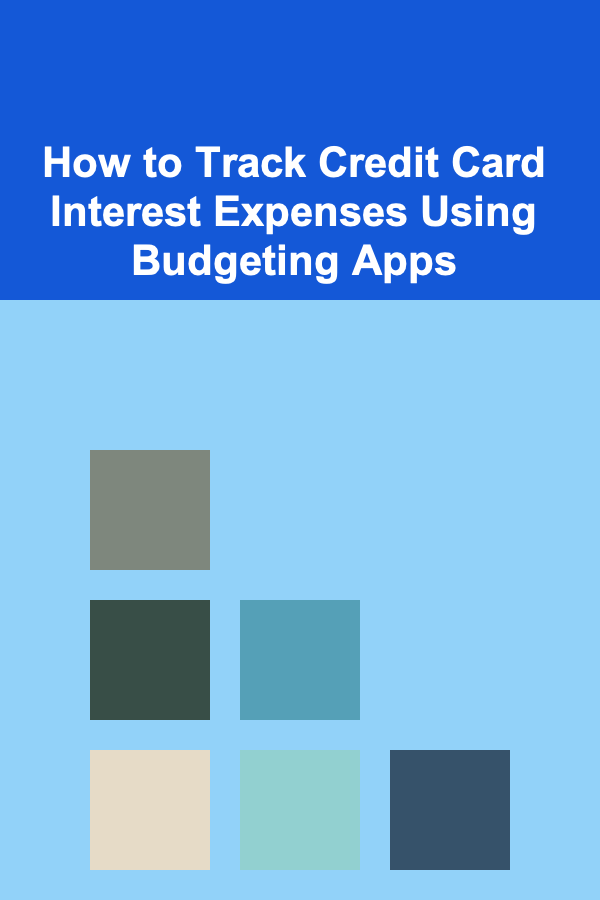
How to Track Credit Card Interest Expenses Using Budgeting Apps
ebook include PDF & Audio bundle (Micro Guide)
$12.99$11.99
Limited Time Offer! Order within the next:

Managing credit card interest expenses can be a challenging task for many people, especially if you have multiple cards or carry a balance from month to month. Credit card interest can accumulate quickly, leading to significant amounts of debt over time. Fortunately, with the help of budgeting apps, tracking these interest expenses becomes much more manageable, allowing you to have a clear understanding of your financial situation and make informed decisions.
In this article, we will explore how to effectively track credit card interest expenses using budgeting apps, why this is important, and the best practices to maximize the benefits of these tools in managing your finances.
Why Tracking Credit Card Interest Expenses is Important
Credit card interest can have a significant impact on your overall financial health. If you're only making the minimum payment each month, your credit card balance may take years to pay off, and the amount of interest paid can far exceed the original purchase amount. Here's why tracking these expenses is crucial:
- Prevents Overspending on Interest: By tracking interest, you can see how much you're paying over time and adjust your spending habits accordingly. Awareness of the interest charges can help you make smarter decisions when using your credit cards.
- Helps in Paying Off Debt Faster: Understanding the interest charges can motivate you to pay off your balance more quickly, avoiding unnecessary interest accumulation.
- Provides Better Financial Control: Knowing your interest expenses helps you keep a more accurate picture of your finances. This can aid in budgeting and managing other financial goals such as savings and investment.
- Improves Credit Score: Consistently paying off credit card debt and reducing your interest expenses can contribute to a healthier credit score. This is because credit card utilization and timely payments are significant factors in credit score calculations.
By using budgeting apps to track interest expenses, you can make more strategic decisions about your credit card usage and better understand the financial implications of carrying a balance.
Understanding Credit Card Interest
Before we delve into the process of tracking credit card interest expenses using budgeting apps, it's essential to understand how credit card interest works. Credit card interest is calculated based on the annual percentage rate (APR), which is the interest rate charged annually for borrowing on the card.
Here are some key concepts related to credit card interest:
- APR: The annual percentage rate, or APR, is the interest rate that applies to the balance you carry on your credit card. This rate can be fixed or variable and is typically higher than other types of loans or credit.
- Daily Periodic Rate (DPR): This is the daily interest rate charged on your credit card balance, which is calculated by dividing your APR by 365 days. The daily periodic rate determines how much interest is applied each day.
- Compounding Interest: Credit card interest is often compounded, meaning interest is charged on both the principal amount and any accumulated interest from previous days.
- Grace Period: Many credit cards offer a grace period, which is the time during which you can pay your balance in full without incurring interest charges. This typically applies to purchases, but not cash advances or balance transfers.
Understanding how interest is calculated and when it's applied helps you track your expenses and avoid unnecessary charges.
Using Budgeting Apps to Track Credit Card Interest Expenses
Budgeting apps are a powerful tool for managing finances, and many of them offer features specifically designed for tracking credit card expenses, including interest. Here's how to use these apps effectively:
3.1 Choosing the Right Budgeting App
There are numerous budgeting apps available, each offering different features and functionalities. When looking for an app to help you track credit card interest, consider the following:
- Expense Tracking: Choose an app that allows you to track both your credit card purchases and the interest charges.
- Credit Card Integration: Some apps allow you to link your credit card accounts directly, making it easier to track your balance, payments, and interest automatically.
- Interest Tracking Features: Not all apps have built-in tools for tracking interest specifically, so look for one that allows you to enter and categorize interest charges.
- Debt Repayment Tools: Many apps offer tools that help you plan and track debt repayment, including credit card balances and interest.
- Alerts and Notifications: Some apps allow you to set up notifications to alert you when interest charges are applied or when your payment due date is approaching.
Popular budgeting apps that offer these features include:
- Mint: Mint is one of the most popular free budgeting apps. It can track credit card transactions, interest charges, and balances in real time by linking your credit card account. Mint categorizes all your expenses, including interest charges, and provides an overview of your financial situation.
- YNAB (You Need a Budget): YNAB helps you allocate money to specific categories and allows you to track credit card expenses, including interest. It encourages proactive budgeting and helps users prioritize paying off credit card debt.
- PocketGuard: PocketGuard is a budgeting app that links to your bank accounts and credit cards. It provides an overview of your financial situation, including credit card balances and interest charges.
- EveryDollar: Created by Dave Ramsey, EveryDollar is a simple and straightforward budgeting tool that allows users to track their expenses and create a plan for paying off credit card debt.
3.2 Linking Your Credit Card Accounts
Most modern budgeting apps allow you to link your credit card accounts directly. This feature automates the process of tracking transactions, including the interest charges that may apply to your balance. Here's how to link your accounts:
- Sign up for an account: If you haven't already, sign up for your chosen budgeting app.
- Add your credit cards: Go to the "accounts" section of the app and select "Add account." You will be prompted to enter your credit card details or sign in through your bank's secure portal to link the card.
- Review transactions: Once your credit card is linked, all your transactions, including any interest charges, will appear in the app automatically.
Some apps also allow you to manually add credit card information if your card doesn't support automatic syncing.
3.3 Tracking Credit Card Interest Expenses
Once your credit card is linked to your budgeting app, you can start tracking your interest expenses. Here are the steps to track interest effectively:
- Categorize Interest Charges: Many budgeting apps allow you to create custom categories for different types of expenses. Create a category specifically for credit card interest and assign all interest charges to this category.
- Set up Alerts: Most apps allow you to set up alerts for due dates and interest charges. You can set up a notification to alert you whenever an interest charge is applied to your credit card balance.
- Track Your Interest Over Time: Regularly review the "credit card" section of your app to see how much interest you're being charged each month. This will give you a clearer picture of your total interest expenses over time.
- Monitor Your Balance: Track how your credit card balance is changing over time. This includes both your purchases and the payments you've made. Ideally, you should try to pay down your balance as much as possible to minimize the interest charged.
By regularly checking the "Interest" category, you can stay on top of how much you're paying and make adjustments to your budget or spending habits accordingly.
3.4 Creating a Debt Repayment Plan
Many budgeting apps also offer features that help you create and stick to a debt repayment plan. For example, apps like YNAB and Mint allow you to set goals and track your progress in paying off credit card debt. These apps can:
- Set debt repayment goals: Determine how quickly you want to pay off your credit card balance and interest and create a plan that fits your budget.
- Track your payments: Monitor your progress by seeing how much of your balance has been paid down and how much interest you've saved by paying down your debt faster.
- Provide debt payoff strategies: Some apps offer advice on the best strategies for paying down your debt, such as the debt snowball or debt avalanche methods, which prioritize either the smallest balances or the highest-interest debt first.
These features help you stay motivated and on track to reduce your credit card interest over time.
3.5 Analyzing Your Credit Card Interest Trends
Over time, you may notice patterns in your credit card interest expenses. For example, you might find that you are consistently charged interest because you carry a balance each month. By analyzing these trends in your budgeting app, you can make more informed decisions about your credit card usage.
For example:
- Adjust spending habits: If you notice that you're accumulating interest because of regular credit card usage, consider reducing your spending or using a different payment method to avoid interest.
- Plan larger payments: If possible, make larger payments toward your balance to reduce the principal amount more quickly, thus reducing the amount of interest you're charged.
- Refinance or transfer balances: If you're carrying a high-interest balance, consider transferring it to a card with a lower interest rate or taking advantage of 0% interest balance transfer offers.
By continuously monitoring your credit card interest charges, you can optimize your approach to managing debt and minimize unnecessary expenses.
Best Practices for Reducing Credit Card Interest Expenses
While tracking interest is important, it's equally vital to take proactive steps to reduce the amount of interest you pay. Here are some best practices for minimizing credit card interest expenses:
4.1 Pay Your Balance in Full Each Month
The best way to avoid credit card interest is to pay off your balance in full each month. If you consistently carry a balance, you'll accrue interest on the outstanding amount. Paying your balance off in full means you won't pay any interest on your purchases.
4.2 Make More Frequent Payments
If paying the full balance each month isn't feasible, consider making more frequent payments throughout the month. Making payments biweekly or even weekly can reduce the average daily balance, which in turn lowers the interest charges.
4.3 Take Advantage of 0% APR Offers
Many credit cards offer introductory 0% APR for balance transfers or purchases for a limited period. Take advantage of these offers to pay down your debt without accumulating interest during the promotional period.
4.4 Use Cards with Lower APR
If you find yourself consistently paying interest on your credit cards, consider transferring your balance to a card with a lower APR. Some cards offer competitive interest rates, especially if you have a good credit score.
4.5 Avoid Cash Advances
Cash advances often come with much higher interest rates and additional fees. Avoid using your credit card for cash advances unless absolutely necessary.
Conclusion
Tracking and managing credit card interest expenses is crucial for maintaining financial health. Budgeting apps provide a convenient and effective way to monitor your interest charges, track spending, and develop strategies for reducing your overall debt. By following the practices outlined in this article, you can take control of your credit card expenses, reduce unnecessary interest, and improve your financial situation over time.
Ultimately, the key to managing credit card interest is awareness. With the right tools and strategies, you can minimize the impact of interest and work toward a debt-free future.
Reading More From Our Other Websites
- [Home Pet Care 101] How to Keep Your Pet Active During Winter Months
- [Personal Care Tips 101] How to Choose an Eye Cream That Targets Signs of Aging
- [Biking 101] Best Bike Maintenance Tutorials for Beginners: Mastering Basic Repairs & Tune‑Ups
- [Home Space Saving 101] How to Use Hidden Storage in Furniture to Save Space
- [Organization Tip 101] How to Assemble a First Aid Kit for Your Emergency Supplies
- [Home Family Activity 101] How to Create a Family Olympics with Fun Events
- [Organization Tip 101] How to Create an Index for Your Recipe Books
- [Home Rental Property 101] How to Offer Furnished Rentals Without Breaking the Bank
- [Organization Tip 101] How to Use a Calendar for Family Activity Planning
- [Organization Tip 101] How to Use Clear Jars for Pantry Organization

How to Clean and Maintain Your Oven and Stove
Read More
How to Create a Checklist for Home Staging
Read More
How to Find Budget-Friendly Furniture That Looks Luxe
Read More
How to Use Furniture Layout to Improve the Flow of Your Home
Read More
How To Incorporate the Y2K Fashion Revival
Read More
How to Manage Your Credit Cards During a Job Loss
Read MoreOther Products

How to Clean and Maintain Your Oven and Stove
Read More
How to Create a Checklist for Home Staging
Read More
How to Find Budget-Friendly Furniture That Looks Luxe
Read More
How to Use Furniture Layout to Improve the Flow of Your Home
Read More
How To Incorporate the Y2K Fashion Revival
Read More